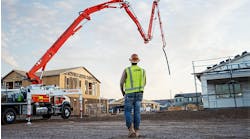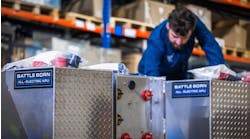Maintaining commercial vehicles has been more challenging than usual lately, with shop managers and supervisors contending with parts and labor shortages as trucks increase in complexity. They may wonder if they are the only ones having trouble nowadays and what to do to work around these shortages. For the second year, Fullbay, a provider of shop management software, intends to shine some light on the issues facing the industry via its State of Heavy-Duty Repair 2021/22 Survey, which is open now until Dec. 11.
While the first survey was sent out to 250 Fullbay customers, this anonymous survey is open to all heavy-duty repair professionals, and the data will be combined with Fullbay benchmarking data into a comprehensive report next year. Along with basic shop profile questions, the survey delves into technician pay and retention strategies, all with the intended goal of providing the industry with greater insights into the health of the heavy-duty maintenance sector and how to remain profitable and efficient.
Some suggested new best practices from the previous survey included offering more services, such as mobile repair, expanding into light- and medium-duty repair, and recognizing technicians’ achievements more.
Fleet Maintenance reached out to Fullbay Executive Chairman Jacob Findlay to get more details on the survey and some speculation on what this new survey will uncover.
Fleet Maintenance: What’s the purpose of this survey, and what do you hope your customers get out of it?
Findlay: With thousands of shops using the Fullbay platform daily, we realized we could pull insights and benchmarks specific to commercial repair that no one else could easily obtain. By combining that data with a survey of not just our customers, but the industry as a whole, we'd be able to provide a free asset to help shops manage their business. We hope shops are able to use the report to understand how they're performing compared to their peers, utilize best practices, and better understand how the industry is handling challenges.
FM: What were the main data takeaways from the last survey?
JF: We spent a lot of time analyzing the impact of COVID-19 on heavy-duty repair and broke it down by both region and industry. There were interesting findings around performance and while naturally some shops struggled, many actually thrived. Another interesting finding was that around 75% of shops have only one location and about half do less than $1 million in revenue—essentially mom-and-pop businesses—and yet they're critical to maintaining the commercial equipment in the supply chain.
FM: Any shop feedback from the 2021 report in regards to if the data helped them improve their technician efficiency and retention?
JF: We've heard from a number of customers who have said the report has been really valuable in providing benchmarks for their business. Most similar reports include data on light-duty repair, which can significantly alter the results and make it less relevant for the commercial side.
Readers of the report have been able to use the heavy-duty focused data to improve how often they cycle count inventory, get a baseline for technician wages, and more. During our anonymous reader survey of the report, one industry professional shared this feedback on last year’s report: “The first report confirmed what we were already doing. It was good to get that confirmation.”
Another professional shared, “I really enjoy what Fullbay has started to do with these reports/webinars. I think that survey or live feedback data during these ... are critical and give a real-time and real-world pulse to the issues that the industry faces today. If we learned anything from 2020 it is that the world can be flipped on its head in a short period of time.”
FM: Last year you surveyed 250 random customers. Who should respond to this survey to make it most effective?
JF: While the shop data we utilize comes from Fullbay customers, we want as diverse a pool of respondents as possible to make it as accurate as possible. Anyone involved in the commercial repair industry, be it a huge fleet or a business owner operating out of the back of a truck, is welcome to participate. For roles, the same applies. We want to hear from technicians, fleet managers, shop owners, and everything in-between. We ask a number of demographic questions to help us segment the results which will allow us to provide insights that are role-specific.
FM: How important is it to get a diverse mix of respondents, particularly age?
JF: Very important. The only way to create a truly accurate report is to have a good representation of the industry. If all we did was survey one specific role in one region, the report wouldn't have nearly the value it does, so it's our top priority to get a proper sampling. Specifically, when it comes to a respondent's age, that is one of the hot topics in the industry when it comes to solving the technician shortage in commercial repair. By asking that question year after year we'll be able to see trends and if efforts to drive more youth to the field have paid off.
FM: Hiring technicians was the top challenge last year. Any predictions for what might it might be this year?
JF: I don't expect much change at the top of the list of challenges. I've heard consistently all year that hiring technicians is still the No. 1 concern and many shops have more work than they can handle.
I think technological challenges will continue to be prevalent and move up the list. This is both because shops need to become more efficient (and technology is the way to do it), but also because their customers are going to demand it.
More and more fleets want a digital repair experience, and they'll start to gravitate to shops that can provide it. Lastly, I think the part shortage could become a bigger factor. With the supply chain squeeze, parts are becoming harder and harder to find, which is costing shops time and money and keeping units out of service longer.




